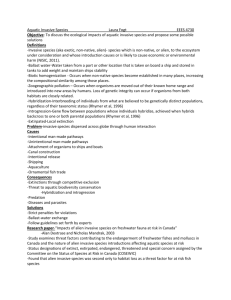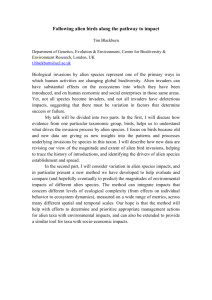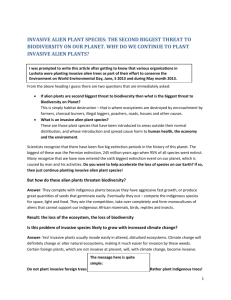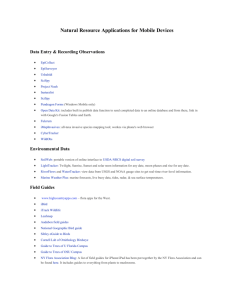IPBES_2_16_Add.3_EN
advertisement
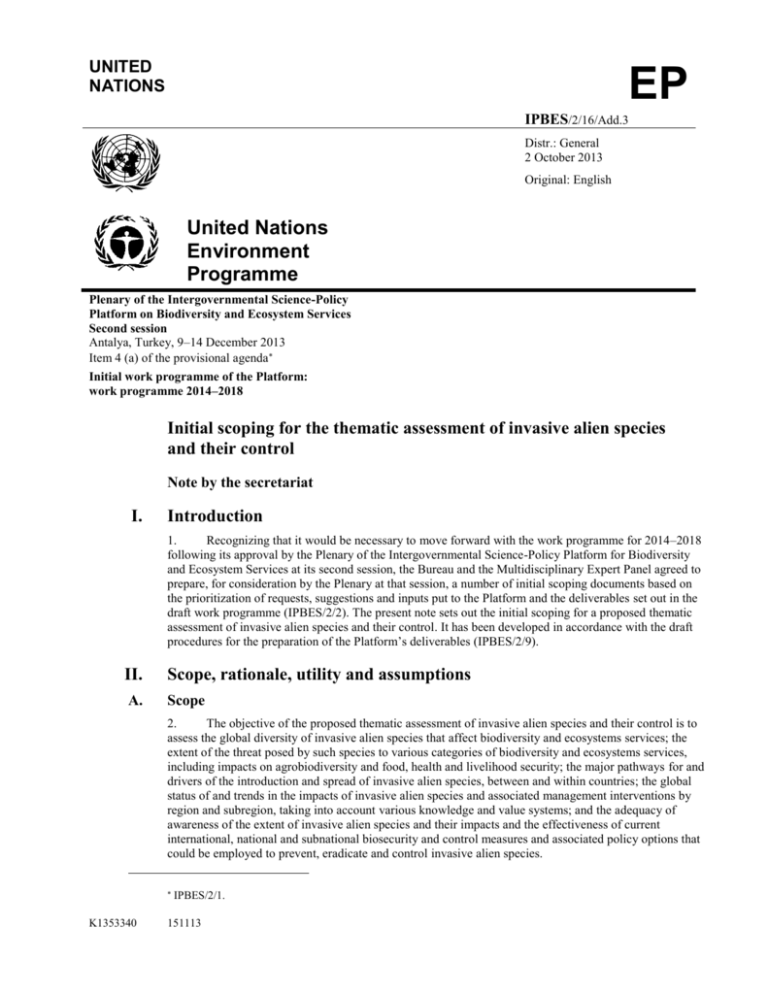
UNITED NATIONS EP IPBES/2/16/Add.3 Distr.: General 2 October 2013 Original: English United Nations Environment Programme Plenary of the Intergovernmental Science-Policy Platform on Biodiversity and Ecosystem Services Second session Antalya, Turkey, 9–14 December 2013 Item 4 (a) of the provisional agenda Initial work programme of the Platform: work programme 2014–2018 Initial scoping for the thematic assessment of invasive alien species and their control Note by the secretariat I. Introduction 1. Recognizing that it would be necessary to move forward with the work programme for 2014–2018 following its approval by the Plenary of the Intergovernmental Science-Policy Platform for Biodiversity and Ecosystem Services at its second session, the Bureau and the Multidisciplinary Expert Panel agreed to prepare, for consideration by the Plenary at that session, a number of initial scoping documents based on the prioritization of requests, suggestions and inputs put to the Platform and the deliverables set out in the draft work programme (IPBES/2/2). The present note sets out the initial scoping for a proposed thematic assessment of invasive alien species and their control. It has been developed in accordance with the draft procedures for the preparation of the Platform’s deliverables (IPBES/2/9). II. Scope, rationale, utility and assumptions A. Scope 2. The objective of the proposed thematic assessment of invasive alien species and their control is to assess the global diversity of invasive alien species that affect biodiversity and ecosystems services; the extent of the threat posed by such species to various categories of biodiversity and ecosystems services, including impacts on agrobiodiversity and food, health and livelihood security; the major pathways for and drivers of the introduction and spread of invasive alien species, between and within countries; the global status of and trends in the impacts of invasive alien species and associated management interventions by region and subregion, taking into account various knowledge and value systems; and the adequacy of awareness of the extent of invasive alien species and their impacts and the effectiveness of current international, national and subnational biosecurity and control measures and associated policy options that could be employed to prevent, eradicate and control invasive alien species. K1353340 IPBES/2/1. 151113 IPBES/2/16/Add.3 B. Rationale 3. The proposed assessment responds directly to Aichi Biodiversity Target 9: “By 2020, invasive alien species and pathways are identified and prioritized, priority species are controlled or eradicated, and measures are in place to manage pathways to prevent their introduction and establishment.” It will also contribute to the achievement of Aichi targets 5, 11, 12 and 17.1 Invasive alien species are acknowledged as major drivers of species extinctions globally; they degrade habitats and have serious impacts on protected areas around the world. 4. Invasive alien species, which include a vast, and rapidly increasing, range of mainly non-native terrestrial and freshwater and marine aquatic vertebrates, invertebrates, plants and disease organisms, constitute one of the most serious, rapidly growing and hard-to-address threats to biodiversity, ecosystem services and food, health and livelihood security. For many countries, invasive alien species are seen as a more serious threat than climate change. Invasive alien species have been responsible for the extinction of native plants and animals, degradation of rare and threatened ecosystems and ecological communities, crop failure and declining agricultural productivity, loss of cultivar and animal breed diversity and damage to property, infrastructure, native fisheries, tourism and outdoor recreation. The threats to native biodiversity from marine invasive alien species, either from deliberate or accidental introductions (e.g., in contaminated ballast water or as encrusting organisms on ships), are increasingly serious and very poorly understood. 5. A high percentage of globally and locally threatened species and ecosystems are at risk owing to competition with or predation or infection by invasive alien species. Whereas pollution and land degradation can be directly reduced, most invasive alien species constitute “living pollution” that will progressively get worse if no action is taken. The cost in loss to biodiversity and human well-being due to invasive alien species, including alien mammals, birds, reptiles, amphibians, fishes, crabs, molluscs, insects, echinoderms, terrestrial and water weeds, seaweeds and a vast array of plant and animal infectious and zoonotic diseases, is difficult to measure. Worldwide, it has been estimated that the cost of damage from invasive alien species exceeds $1.4 trillion, amounting to 5 per cent of the global economy; in the United States of America, the cost alone have been estimated at $120 billion, with over 100 million acres, the size of California, being affected, while in Europe the economic losses have been estimated at over €12.5 billion per year. The impacts on oceanic islands are even more serious, with a majority of all extinctions of mammals, birds, amphibians, reptiles, land crabs, land snails and insects being directly or indirectly the result of invasive alien species. The economic, environmental and social costs of the use of pesticides to control invasive alien species are also a major cause of the loss of biodiversity and environmental pollution and are a threat to human health. C. Utility 6. The rapidly growing threat that invasive alien species pose to biodiversity, sustainable development and human well-being are generally poorly quantified and poorly understood by policymakers. The proposed assessment, if undertaken, will raise awareness of the nature and seriousness of the threat posed by invasive alien species; identify policies that are required at the international level and by Governments, the private sector and civil society to help stop the spread of, eradicate or control the impacts of invasive alien species; and represent an early deliverable of the Platform that highlights how it can add value to policy formulation to address the biodiversity crisis. D. Assumptions 7. The proposed assessment will be based on existing scientific literature and national assessments and will draw on the work of existing institutions and networks such as the International Union for Conservation of Nature/Species Survival Commission (IUCN/SSC) Invasive Species Specialist Group, the IUCN Invasive Species Initiative, BirdLife International’s Invasive Alien Species Programme, CAB International, the Global Invasive Alien Species Information Partnership (an initiative supported by the secretariat of the Convention on Biological Diversity), the Food and Agriculture Organization of the United Nations, especially its agriculture, aquaculture and forestry divisions, and other relevant international and regional expert bodies. It will also endeavour to assess the regional status of invasive alien species by building synergies with indigenous and local knowledge systems, as local communities of 1 2 Available at http://www.cbd.int/sp/targets. IPBES/2/16/Add.3 farmers, hunters, fishers and other local experts may have the best time-depth knowledge of the history, pathways, changing impacts and the effectiveness of efforts to manage invasive alien species. III. Chapter outline 8. It is contemplated that the results of the thematic assessment will be presented in a six-chapter report, as set out below. 9. Chapter 1. Introduction to the concepts of invasive alien species, including: (a) The current and future risks they pose; (b) Their diversity, origins, means and pathways of introduction and spread, ecology, seriousness of their impacts; (c) The need for awareness and appropriate pre- and post-border biosecurity policies to respond to their impacts and spread; (d) Methodologies and information systems to monitor their extent, spread and impact. 10. Chapter 2. Overview of the types of invasive alien species, their means and history of spread and the types of impacts, broken down by region, that they have on biodiversity, ecosystem services and human well-being. Major taxonomic groups to be covered include: (a) Vertebrates (e.g., rats, mice, possums, mongooses, cats, goats, deer, pigs, horses, cattle, camels, foxes, rabbits, monkeys, snakes, lizards, turtles, toads and frogs, birds and fish); (b) Invertebrates (e.g., ants, mosquitoes, flies, wasps, aphids, beetles, termites, cockroaches, locusts, moths, crabs, snails, slugs and other molluscs, flatworms), especially colonial organisms such as ants and wasps and mosquito vectors of disease that seem to be extending their ranges; (c) Plants (e.g., trees, shrubs, vines, grasses, herbs, seaweeds and algae); (d) Diseases and micro-organisms (e.g., fungi, viruses, bacteria, cyanobacteria, protozoa, coral diseases, plankton, parasites). 11. Other issues to be covered in chapter 2 include: (a) Areal extent of and trends in loss of biodiversity and ecosystem services, land degradation and loss of food and livelihood security due to invasive alien species in all regions and subregions; (b) Assessment of thresholds and scale of change (both positive and negative), including the recent arrival of new invasive alien species; (c) Reconciliation of existing information with indigenous and local knowledge. 12. Chapter 3. Global assessment of the direct and indirect drivers responsible for the increasing number and impacts of invasive alien species. This will be a critical analysis that will include: (a) An assessment of indirect drivers of change such as the increased movement of commodities and other materials by sea, air and land transport, trade and agricultural policies, including increasing monoculture and plantation forestry of potentially invasive species, and the spread of species valued by local communities for firewood and other purposes; (b) Climate change, which in several regions of the world is expected to increase the rate and impacts of invasions; (c) Inadequate awareness and international and national biosecurity procedures, including an assessment of direct drivers leading to the increasing dominance of invasive alien species such as land-use change and degradation, which favour invasion, and pesticide use. 13. Chapter 4. Global assessment of the environmental, economic and social costs of invasive alien species, with particular focus on their impact on biodiversity and ecosystem services, including 3 IPBES/2/16/Add.3 non-economic values, e.g., cultural, social and shared, recreational, scientific, spiritual and aesthetic. This would include global and regional case studies of impacts of invasive alien species on biodiversity, ecosystem services and food, health and livelihood security and policy options. 14. Chapter 5. Review of institutional arrangements, options and existing programmes, including their effectiveness, for global, national and local management of invasive alien species, including both preborder and border approaches to strengthening biosecurity and building awareness of invasive alien species issues. This will be based on assessing best practices and the effectiveness of existing programmes to address risks, including national quarantine measures. The chapter will also consider and analyse the options for: (a) Preventing the international and intranational spread of invasive alien species, including the possible role of the Convention on Biological Diversity; (b) Eradicating or managing invasive alien species once they are present, including control options such as precision application of pesticides, baits and biological control and other best practices. 15. Potential trade-offs and options for policy responses in relevant sectors and implications of inaction would also be assessed. This would include a comprehensive analysis of relatively common risks related to the absence of relevant policies for controlling invasive alien species such as a lack of customs controls, the lack of a precautionary approach to tourism and similar matters. 16. Chapter 6. Creating or strengthening existing networks and national capacities for global awareness-raising, early warning systems on the diversity and seriousness of the impacts of invasive alien species on biodiversity and rapid response strategies, with specific emphasis on strengthening international and intergovernmental networks and strategies and procedures for forecasting, preventing the spread of invasive alien species and eradicating and controlling them in order to conserve biodiversity as a basis for promoting human well-being. IV. Process and timetable 17. The process proposed for undertaking the thematic assessment and the timetable for carrying it out are outlined in the following table. Time frame Fourth quarter 2013 Fourth quarter First quarter Second quarter 2014 Second quarter Second quarter Second quarter 4 Actions The Plenary reviews and approves the initial scoping exercise prepared by the Multidisciplinary Expert Panel and requests the Panel and the Bureau, within an agreed cost envelope, to proceed with a full assessment after the completion of the detailed scoping study (14 December 2013) The Panel, through the Secretariat, requests nominations from Governments and other stakeholders for experts to assist with the scoping process (16 December 2013–31 January 2014) The Panel, via e-mail and teleconferences, selects experts for the scoping study using the approved selection criteria (see IPBES/2/9) (1–14 February 2014) The Panel and the Bureau oversee the detailed scoping exercise, including outline, costs and feasibility (3 months). A scoping meeting is held at the beginning of April 2014 The detailed scoping report is sent to members of the Platform and other stakeholders for review and comment for two weeks in the second half of April 2014 On the basis of the results of the detailed scoping exercise, and comments received from members of the Platform and other stakeholders, the Panel and the Bureau decide whether to proceed with the assessment, assuming that it can be conducted within the budget envelope approved by the Plenary, in the first half of May 2014 The Panel, through the secretariat, requests nominations from Governments IPBES/2/16/Add.3 Time frame Actions Third quarter Third/fourth quarter First quarter Second quarter 2015 Third quarter Third/fourth quarter Fourth quarter First quarter 2016 First quarter V. and other stakeholders for experts to prepare the assessment report. Nominations are to be submitted by the end of June 2014 (1.5 months) The Panel selects the report co-chairs, coordinating lead authors, lead authors and review editors using the selection criteria (see IPBES 2/9) (1 July–15 August 2014) (1.5 months) The report co-chairs, coordinating lead authors and lead authors prepare the initial draft of the report by mid-February 2015 (6 months). A first author meeting is held in September 2014 The initial draft report is reviewed by experts until end of March 2015 (1.5–2 months) The report co-chairs, coordinating lead authors and lead authors prepare the second draft of the report and an initial draft of the summary for policymakers under the guidance of the review editors and the Panel (April–June 2015) (3 months). A second author meeting is held in June 2015 The second draft of the report and the initial draft of the summary for policymakers are reviewed by experts, Governments and other stakeholders during July and August 2015 (2 months) The report co-chairs, coordinating lead authors and lead authors prepare the final draft of the report and the final draft of the summary for policymakers under the guidance of the review editors and the Panel during September and October 2015 (2 months). A third author meeting is held in October 2015 The summary for policymakers is translated into all the official languages of the United Nations by mid-December 2015 at the latest (1.5 months) The final draft report and summary for policymakers are sent to Governments and other stakeholders for final review during January and February 2016 (1.5–2 months). Written comments from Governments on the draft summary for policymakers are strongly encouraged. Such comments must be submitted to the secretariat one week prior to the fourth session of the Plenary The Plenary reviews and accepts the report and reviews and approves the summary for policymakers at its fourth session, in March 2016 Cost estimate 18. The table below shows the estimated cost of conducting the assessment and preparing the thematic assessment report. (United States dollars) Year 2014 Cost item Assumptions Scoping meeting (25 participants: Multidisciplinary Expert Panel/Bureau members, experts) Meeting costs (1 week, 25 participants) (25 per cent in kind) Travel and DSA (19 x $3,000 USD) 57 000 First author meeting (50 co-chairs, coordinating lead authors and lead authors, plus 4 Panel/Bureau members, plus 1 technical support staff member) Meeting costs (1 week, 55 participants) (25 per cent in kind) 11 250 Technical support 2015 Second author meeting (50 co-chairs, coordinating lead authors and lead authors, plus 10 review Travel and DSA (41 x $3,000) Cost 7 500 123 000 1 full-time equivalent professional position (50 per cent in kind) 75 000 Meeting costs (1 week, 65 participants) (25 per cent in kind) 15 000 Travel and DSA (49 x $3,000) 147 000 5 IPBES/2/16/Add.3 Year Cost item Assumptions Cost editors, plus 4 Panel/Bureau members, plus 1 technical support staff member) Third author meeting (50 co-chairs, coordinating lead authors and lead authors, plus 10 review editors, plus 4 Panel/Bureau members, plus1 technical support staff member) Technical support 2016 Total 6 Meeting costs (1 week, 65 participants) (25 per cent in kind) Travel and DSA (49 x $3,000) 1 full-time equivalent professional position (50 per cent in kind) Participation by 2 co-chairs and 2 coordinating lead authors in the fourth session of the Plenary Travel and DSA (3 x $3,000) Dissemination and outreach (summary for policymakers (10 pages) and report (200 pages)) Translation of the summary for policymakers into all the official languages of the United Nations, publication and outreach 15 000 147 000 75 000 9 000 117 000 798 750 IPBES/2/16/Add.3 References Steven L. Coles and others, “Historical and recent introductions of non-indigenous marine species into Pearl Harbor, Oahu, Hawaiian Islands”, Marine Biology, vol. 135, No. 1 (1999), pp.147-158. Coordinating Group on Alien Pest Species, Stop the Silent Invasion (Honolulu, 1996). Francis Howarth, “Impacts of alien land arthropods and molluscs on native plants and animals in Hawaii”, in Hawaii's Terrestrial Ecosystems: Preservation and Management, eds. C. P. Stone and J. Michael Scott (Honolulu, University of Hawaii Press, 1985). Marianne Kettunen and others, Technical support to EU strategy on invasive alien species (IAS): Assessment of the impacts of IAS in Europe and the EU (Brussels, Institute for European Environmental Policy, 2009). J. Le Breton, J. Chazeau and H. Jourdan, “Immediate impacts of invasion by Wasmannia auropunctata (Hymenoptera: Formicidae) on native litter ant fauna in a New Caledonian rainforest”, Austral Ecology, vol. 28, No. 2 (2003), pp. 204–209. Sarah Lowe and others, 100 of the World’s Worst Invasive Alien Species: A Selection from the Global Invasive Species Database (IUCN Invasive Species Specialist Group, 2000) (available at http://www.issg.org/database/species/reference_files/100English.pdf). Jean Bruno Mikissa and others “Preliminary Assessment on the Interactions of Wasmannia auropunctata in Native Ant Communities (Hymenoptera: Formicidae) of a Mosaic Gallery Forest/Savannah in Lope National Park, Gabon”, Sociobiology, vol. 51, No. 1 (2008), pp. 207–218. David Pimentel and others, “Environmental and economic costs of nonindigenous species in the United States”, Bioscience, vol. 50, No. 1 (2000), pp. 53–65. David Pimentel, Rodolfo Zuniga and Doug Morrison, “Update on the environmental and economic costs associated with alien invasive species in the United States”, Ecological Economics, vol. 52, No. 3 (2005), pp. 273–288. Gordon H. Rodda and Thomas H. Fritts, “The brown tree snake on Pacific islands”, Pacific Science Association Information Bulletin, vol. 45, No. 3–4 (Sept.–Dec. 1993), pp. 1–3. Daniel Simberloff and others, “Impacts of biological invasions: what’s what and the way forward”, Trends in Ecology & Evolution, vol. 28, No. 1 (2013), pp. 58–66. United States Forest Service, “Pacific Island Ecosystems at Risk (PIER)”, available at http://www.hear.org/pier (accessed 2 October 2013). Kendra L. Walker, “Impact of the little fire ant, Wasmannia auropunctata, on native forest ants in Gabon”, Biotropica, vol. 38, No. 5 (2006), pp. 666–673. James K. Wetterer, P. D. Walsh and L. J. T. White, “Wasmannia auropunctata (Roger) (Hymenoptera: Formicidae), a destructive tramp-ant, in wildlife refuges of Gabon”, African. Entomology, vol. 7, No. 2 (1999), pp. 292–294. James K. Wetterer, “Worldwide spread of the destroyer ant, Monomorium destructor (Hymenoptera: Formicidae)”, Myrmecological News, vol. 12 (2009), pp. 97–118. United States Geological Survey Invasive Species Programme, available at www.usgs.gov/ecosystems/invasive_species/. 7
